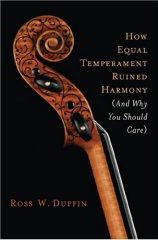My friend Bill Hogeland alerted me to the arrival of a new book that I’m shocked had slipped under my microtonality radar: How Equal Temperament Ruined Harmony (and Why You Should Care) (Norton). It’s by Ross W. Duffin, who heads the early music program at Case Western Reserve University, and who argues that we need to go back and try out the tunings that pre-20th-century composers wrote their music in. He’s not a microtonalist, and there’s no mention of Partch, Johnston, La Monte Young, et al, but it’s an elegantly readable exposition of what the temperament arguments are all about.
 Duffin apparently started the book as a much-needed antidote to Stuart Isacoff’s mendacious and unaccountably popular Temperament: The Idea that Solved Music’s Greatest Riddle of several years back. Isacoff’s populist tome was a heady celebration of the status quo: “hey, 12 equal steps to the octave is the perfect tuning, aren’t we glad they came up with it, no reason to ever consider anything else!” To argue that, he had to sweep a mountain of inconvenient acoustic phenomena under the rug. (I wrote a Village Voice review saying so, and, comically, Isacoff wrote a letter to the editor excoriating me as – I quote from memory – “one of those dogmatic pedants who can only imagine doing a thing one way.” Of course, the “one way” I pedantically insisted on was allowing and exploring thousands of different tunings; the open-minded route he so generously opened up was to impose one bland, invariant scale on all mankind’s music for the rest of eternity.) Strangely for so esoteric a topic, Isacoff’s Temperament got a tsunami of undeserved publicity.
Duffin apparently started the book as a much-needed antidote to Stuart Isacoff’s mendacious and unaccountably popular Temperament: The Idea that Solved Music’s Greatest Riddle of several years back. Isacoff’s populist tome was a heady celebration of the status quo: “hey, 12 equal steps to the octave is the perfect tuning, aren’t we glad they came up with it, no reason to ever consider anything else!” To argue that, he had to sweep a mountain of inconvenient acoustic phenomena under the rug. (I wrote a Village Voice review saying so, and, comically, Isacoff wrote a letter to the editor excoriating me as – I quote from memory – “one of those dogmatic pedants who can only imagine doing a thing one way.” Of course, the “one way” I pedantically insisted on was allowing and exploring thousands of different tunings; the open-minded route he so generously opened up was to impose one bland, invariant scale on all mankind’s music for the rest of eternity.) Strangely for so esoteric a topic, Isacoff’s Temperament got a tsunami of undeserved publicity.
Enter, thankfully, Duffin (who alludes to Isacoff’s book, though not by title). His book is just as entertainingly written, just as acutely aimed at the average music fan, and possesses the inestimable advantage of being accurate. He starts off from, and keeps returning to, Pablo Casals’s dictum that, in string playing, sharped notes should be raised and flatted notes should be lowered: “leading notes should lead.” But, once granted that possibility, he shows meticulously how no one style of intonation is good for all musics, arguing that players should adjust their intonation to fit the historical style. His history of tuning theory is quick, concise, and as painless as possible. At one point, before giving some numbers, he adds, “Note to mathophobes: This is not math, it’s arithmetic.” (On the same impulse I call my tuning course The Arithmetic of Listening, not “The Mathematics.”) His history and theory are admirably accurate, and he gives perhaps the simplest exposition I’ve seen of the 18th-century theory of dividing the octave into 55 parts, using a minor half-step of four units (C to C#) and a major half-step of five units (C to Db). We know for a fact that’s the intonation Mozart taught, folks, and as Duffin adds:
Are modern practices better than what Mozart had in mind? I don’t think so, and I don’t think most musicians would deliberately go against the expectations of a composer like Mozart if they knew what those expectations were. And even though the sound of lower sharps and higher flats is likely to be unfamiliar to many musicians, I think Mozart’s endorsement makes it worth trying… and trying very seriously. [Ellipsis in the original]
This is above all a practical book, brief and to the point, “because every musician I know would rather be making music than reading about it any day.” Keyboard instruments he all but despairs of, and he even quotes Casals:”Do not be afraid to be out of tune with the piano. It is the piano that is out of tune.” Duffin gears his argument toward singers, wind players, and especially string players, and includes some wonderful quotations about intonational practice from old-style, Old World quartet players. I might add to Duffin’s argument that I keep my own pianos, at the office and at home, in Thomas Young’s Well Temperament of 1799, and that I find it preferable in every respect, for every kind of music, to Equal Temperament. The problem with that, as Duffin emphasizes, is that, in tuning, there’s no one-size-fits-all:
I am perfectly aware that what I am suggesting is a radical idea for musicians and that it is likely to be met with reluctance, resistance, and even scorn in some quarters. Some musicians will be convinced by my arguments but may still view unequal tuning as a Pandora’s box to be opened carefully or not at all; others will scoff at the long historical pedigree of extended meantone as irrelevant; still others will find both the harmonic and melodic intervals strangeand “out of tune.” At least that’s how it may seem to some the first time they hear it or try it. But my experience has been that an hour or so of experimenting over two or three sessions is all that’s necessary to help musicians begin, at least, to appreciate what non-ET tuning has to offer from a musical point of view…. [T]he testimonials of Bach and Mozart have to count for something. What makes it worth trying is that it makes the music sound better. And remember, I’m not saying that harmonic intonation should replace ET entirely and substitute its own tyranny; only that ET is not necessarily the best temperament for every single musical situation….
Now that’s someone who can imagine doing a thing more than one way. Bill saw a stack of Duffin’s books on display at Barnes & Noble, so maybe we’ll finally hear the bland hegemony of ET – that heavily-processed Wonder Bread of tunings – start to erode. And once that happens: microtonality, here we come!

 Through some passages of Feldman’s late works, it is remarkable – too remarkable for mere coincidence – how often his textures change at the end of a page. It doesn’t seem true at the beginnings of pieces, which will often be seamless. But at some point in a work, he will begin to settle into a rhythm. A texture or pitch set will be consistent for a page, and then the next page will have a different texture and pitch set, and the next page a different one still, and so on. It is almost as though he treated the page visually, as a whole, and every time he turned to a new page, thought, “Now for something new.”
Through some passages of Feldman’s late works, it is remarkable – too remarkable for mere coincidence – how often his textures change at the end of a page. It doesn’t seem true at the beginnings of pieces, which will often be seamless. But at some point in a work, he will begin to settle into a rhythm. A texture or pitch set will be consistent for a page, and then the next page will have a different texture and pitch set, and the next page a different one still, and so on. It is almost as though he treated the page visually, as a whole, and every time he turned to a new page, thought, “Now for something new.”